An Analysis of Leadership and Management in the Context of M&S
VerifiedAdded on 2020/07/23
|15
|4225
|31
Report
AI Summary
This report provides a comprehensive analysis of leadership and management within the context of M&S, a multinational retail company. It begins by defining the distinct roles and characteristics of leaders and managers, highlighting their importance in achieving organizational success. The report then explores how these roles are implemented in various situations, such as decision-making, training, and employee engagement. Furthermore, it elaborates on different leadership theories, including system leadership, contingency and situational leadership, and trait leadership, discussing their application and impact on organizational development. The report also delves into key approaches to operational management, emphasizing its significance in optimizing resource utilization and achieving desired outcomes. Finally, it examines the factors within the business environment that influence operational management, providing a holistic understanding of leadership and management practices in a real-world business setting.
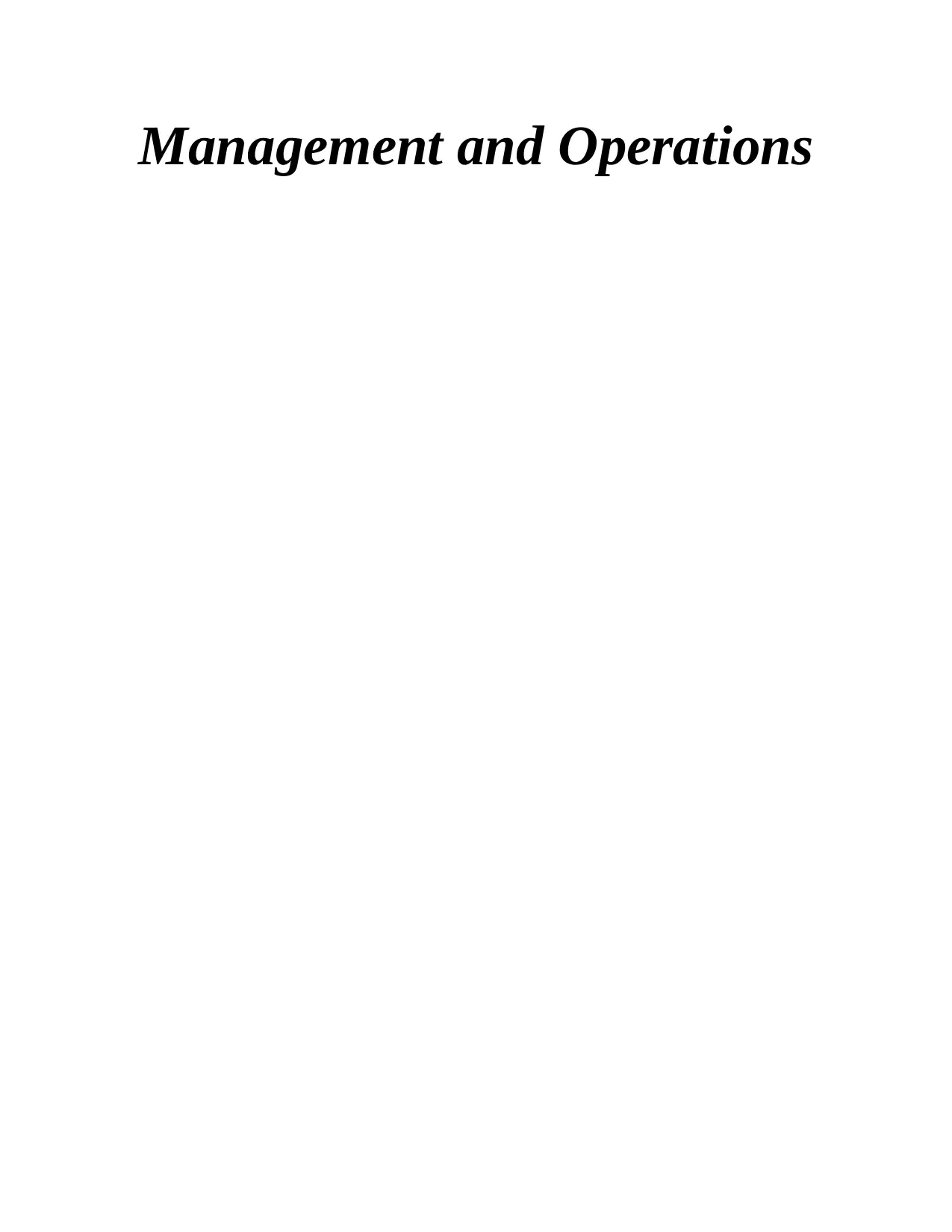
Management and Operations
Paraphrase This Document
Need a fresh take? Get an instant paraphrase of this document with our AI Paraphraser
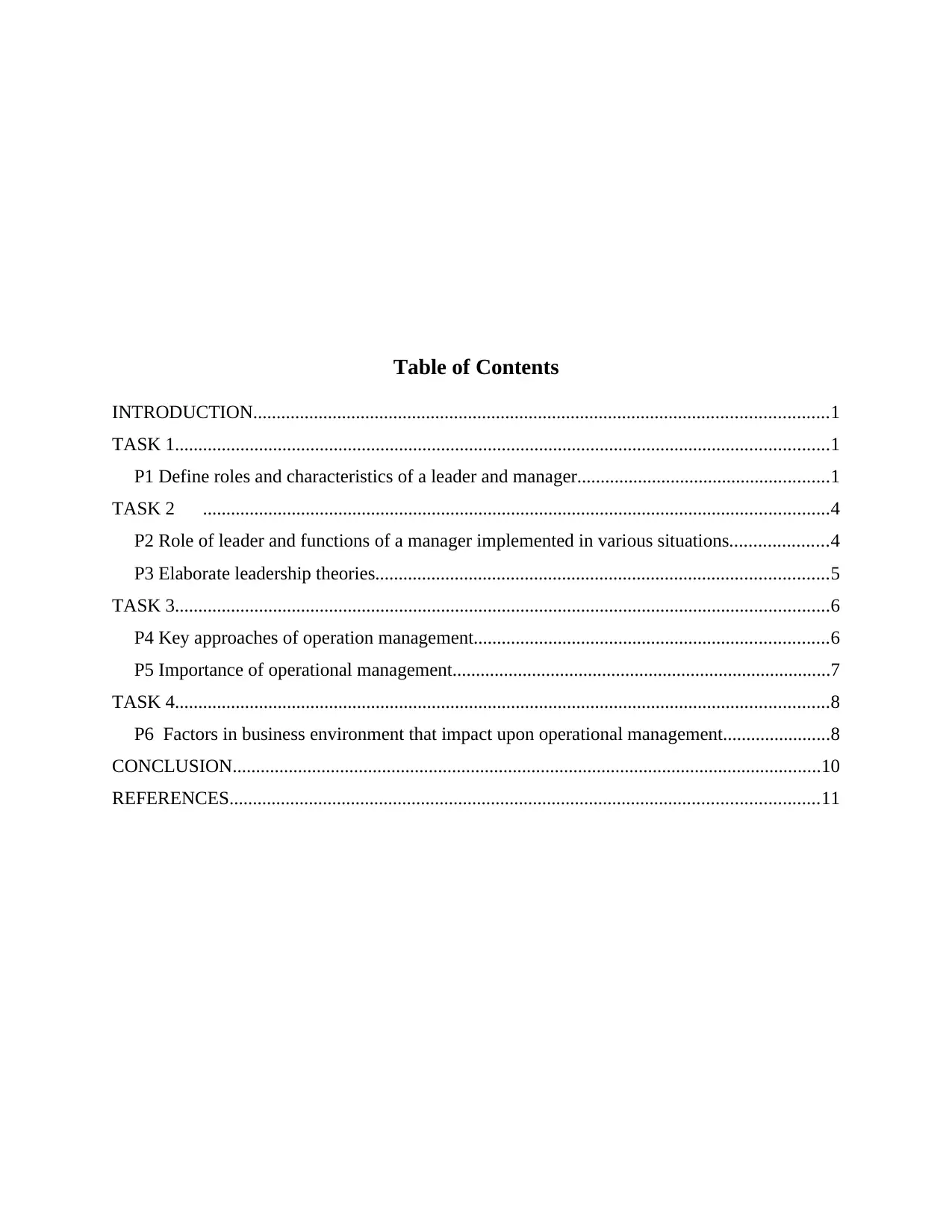
Table of Contents
INTRODUCTION...........................................................................................................................1
TASK 1............................................................................................................................................1
P1 Define roles and characteristics of a leader and manager......................................................1
TASK 2 ......................................................................................................................................4
P2 Role of leader and functions of a manager implemented in various situations.....................4
P3 Elaborate leadership theories.................................................................................................5
TASK 3............................................................................................................................................6
P4 Key approaches of operation management............................................................................6
P5 Importance of operational management.................................................................................7
TASK 4............................................................................................................................................8
P6 Factors in business environment that impact upon operational management.......................8
CONCLUSION..............................................................................................................................10
REFERENCES..............................................................................................................................11
INTRODUCTION...........................................................................................................................1
TASK 1............................................................................................................................................1
P1 Define roles and characteristics of a leader and manager......................................................1
TASK 2 ......................................................................................................................................4
P2 Role of leader and functions of a manager implemented in various situations.....................4
P3 Elaborate leadership theories.................................................................................................5
TASK 3............................................................................................................................................6
P4 Key approaches of operation management............................................................................6
P5 Importance of operational management.................................................................................7
TASK 4............................................................................................................................................8
P6 Factors in business environment that impact upon operational management.......................8
CONCLUSION..............................................................................................................................10
REFERENCES..............................................................................................................................11
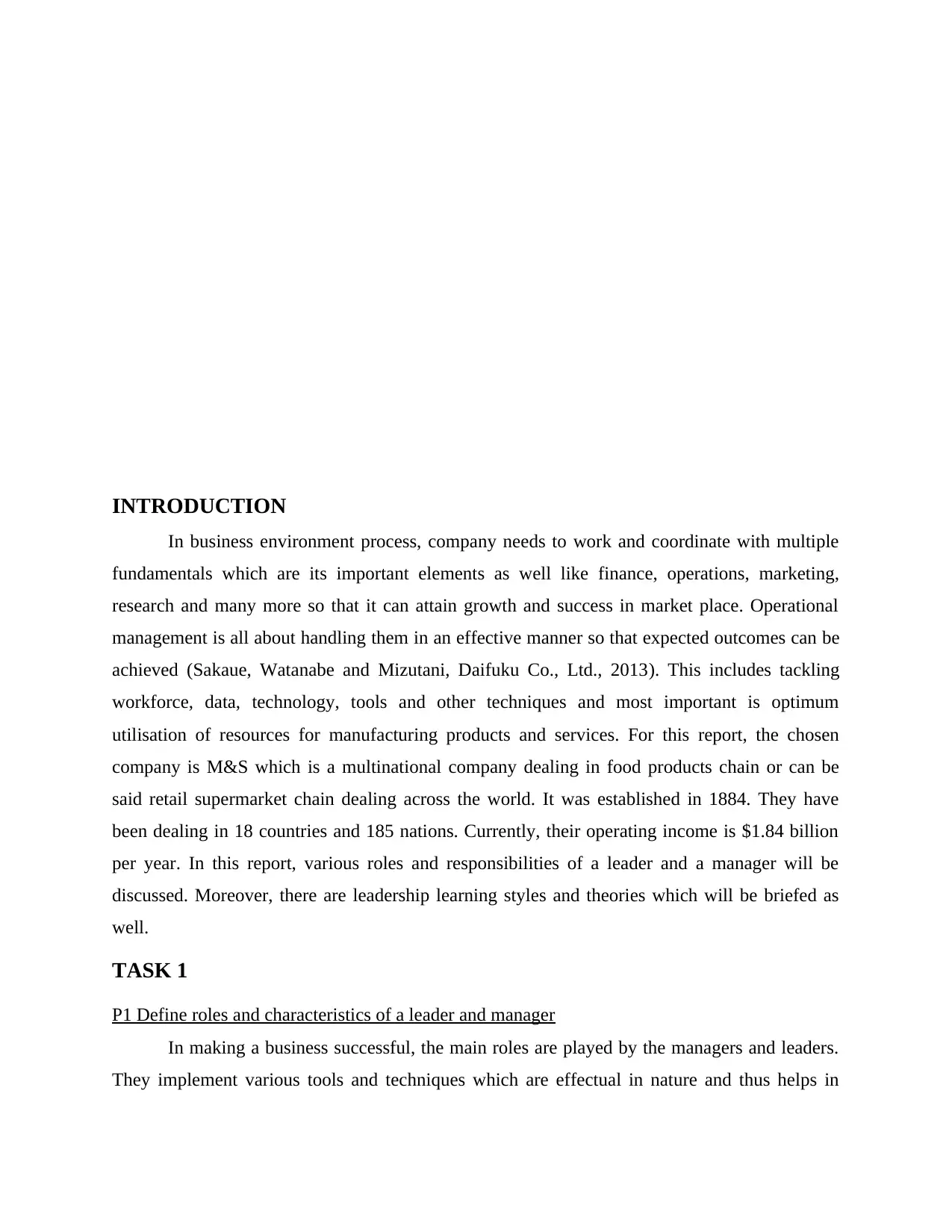
INTRODUCTION
In business environment process, company needs to work and coordinate with multiple
fundamentals which are its important elements as well like finance, operations, marketing,
research and many more so that it can attain growth and success in market place. Operational
management is all about handling them in an effective manner so that expected outcomes can be
achieved (Sakaue, Watanabe and Mizutani, Daifuku Co., Ltd., 2013). This includes tackling
workforce, data, technology, tools and other techniques and most important is optimum
utilisation of resources for manufacturing products and services. For this report, the chosen
company is M&S which is a multinational company dealing in food products chain or can be
said retail supermarket chain dealing across the world. It was established in 1884. They have
been dealing in 18 countries and 185 nations. Currently, their operating income is $1.84 billion
per year. In this report, various roles and responsibilities of a leader and a manager will be
discussed. Moreover, there are leadership learning styles and theories which will be briefed as
well.
TASK 1
P1 Define roles and characteristics of a leader and manager
In making a business successful, the main roles are played by the managers and leaders.
They implement various tools and techniques which are effectual in nature and thus helps in
In business environment process, company needs to work and coordinate with multiple
fundamentals which are its important elements as well like finance, operations, marketing,
research and many more so that it can attain growth and success in market place. Operational
management is all about handling them in an effective manner so that expected outcomes can be
achieved (Sakaue, Watanabe and Mizutani, Daifuku Co., Ltd., 2013). This includes tackling
workforce, data, technology, tools and other techniques and most important is optimum
utilisation of resources for manufacturing products and services. For this report, the chosen
company is M&S which is a multinational company dealing in food products chain or can be
said retail supermarket chain dealing across the world. It was established in 1884. They have
been dealing in 18 countries and 185 nations. Currently, their operating income is $1.84 billion
per year. In this report, various roles and responsibilities of a leader and a manager will be
discussed. Moreover, there are leadership learning styles and theories which will be briefed as
well.
TASK 1
P1 Define roles and characteristics of a leader and manager
In making a business successful, the main roles are played by the managers and leaders.
They implement various tools and techniques which are effectual in nature and thus helps in
⊘ This is a preview!⊘
Do you want full access?
Subscribe today to unlock all pages.

Trusted by 1+ million students worldwide
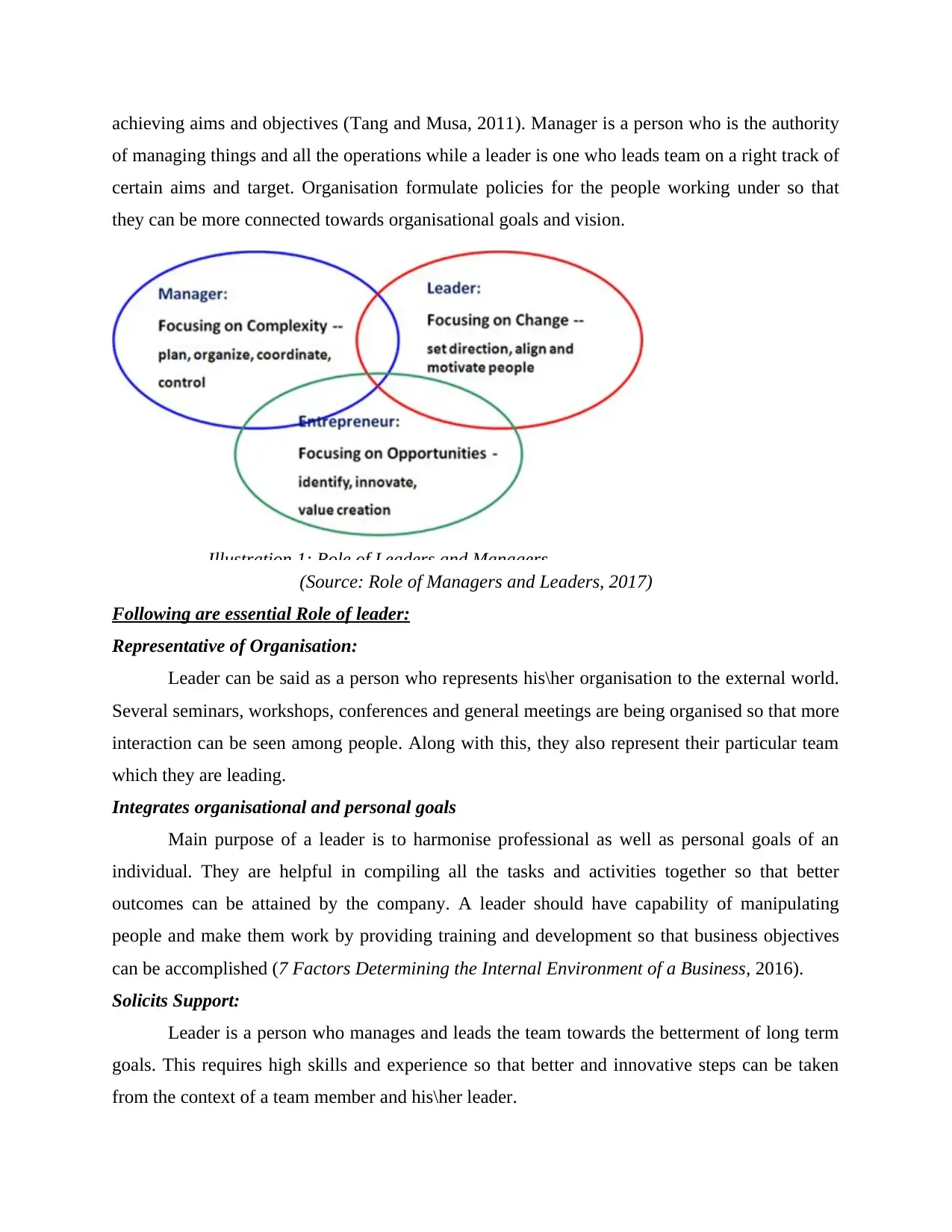
achieving aims and objectives (Tang and Musa, 2011). Manager is a person who is the authority
of managing things and all the operations while a leader is one who leads team on a right track of
certain aims and target. Organisation formulate policies for the people working under so that
they can be more connected towards organisational goals and vision.
Illustration 1: Role of Leaders and Managers
(Source: Role of Managers and Leaders, 2017)
Following are essential Role of leader:
Representative of Organisation:
Leader can be said as a person who represents his\her organisation to the external world.
Several seminars, workshops, conferences and general meetings are being organised so that more
interaction can be seen among people. Along with this, they also represent their particular team
which they are leading.
Integrates organisational and personal goals
Main purpose of a leader is to harmonise professional as well as personal goals of an
individual. They are helpful in compiling all the tasks and activities together so that better
outcomes can be attained by the company. A leader should have capability of manipulating
people and make them work by providing training and development so that business objectives
can be accomplished (7 Factors Determining the Internal Environment of a Business, 2016).
Solicits Support:
Leader is a person who manages and leads the team towards the betterment of long term
goals. This requires high skills and experience so that better and innovative steps can be taken
from the context of a team member and his\her leader.
of managing things and all the operations while a leader is one who leads team on a right track of
certain aims and target. Organisation formulate policies for the people working under so that
they can be more connected towards organisational goals and vision.
Illustration 1: Role of Leaders and Managers
(Source: Role of Managers and Leaders, 2017)
Following are essential Role of leader:
Representative of Organisation:
Leader can be said as a person who represents his\her organisation to the external world.
Several seminars, workshops, conferences and general meetings are being organised so that more
interaction can be seen among people. Along with this, they also represent their particular team
which they are leading.
Integrates organisational and personal goals
Main purpose of a leader is to harmonise professional as well as personal goals of an
individual. They are helpful in compiling all the tasks and activities together so that better
outcomes can be attained by the company. A leader should have capability of manipulating
people and make them work by providing training and development so that business objectives
can be accomplished (7 Factors Determining the Internal Environment of a Business, 2016).
Solicits Support:
Leader is a person who manages and leads the team towards the betterment of long term
goals. This requires high skills and experience so that better and innovative steps can be taken
from the context of a team member and his\her leader.
Paraphrase This Document
Need a fresh take? Get an instant paraphrase of this document with our AI Paraphraser
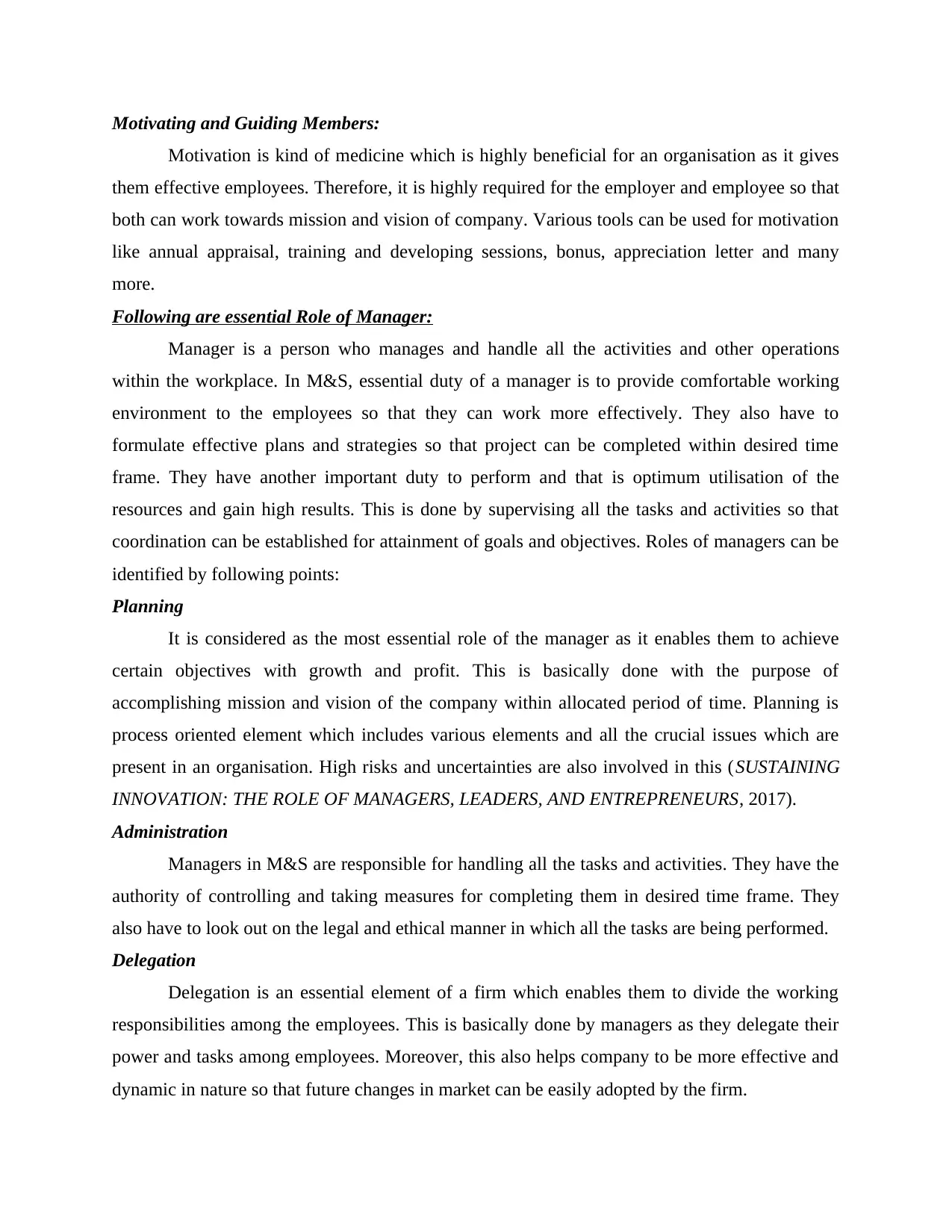
Motivating and Guiding Members:
Motivation is kind of medicine which is highly beneficial for an organisation as it gives
them effective employees. Therefore, it is highly required for the employer and employee so that
both can work towards mission and vision of company. Various tools can be used for motivation
like annual appraisal, training and developing sessions, bonus, appreciation letter and many
more.
Following are essential Role of Manager:
Manager is a person who manages and handle all the activities and other operations
within the workplace. In M&S, essential duty of a manager is to provide comfortable working
environment to the employees so that they can work more effectively. They also have to
formulate effective plans and strategies so that project can be completed within desired time
frame. They have another important duty to perform and that is optimum utilisation of the
resources and gain high results. This is done by supervising all the tasks and activities so that
coordination can be established for attainment of goals and objectives. Roles of managers can be
identified by following points:
Planning
It is considered as the most essential role of the manager as it enables them to achieve
certain objectives with growth and profit. This is basically done with the purpose of
accomplishing mission and vision of the company within allocated period of time. Planning is
process oriented element which includes various elements and all the crucial issues which are
present in an organisation. High risks and uncertainties are also involved in this (SUSTAINING
INNOVATION: THE ROLE OF MANAGERS, LEADERS, AND ENTREPRENEURS, 2017).
Administration
Managers in M&S are responsible for handling all the tasks and activities. They have the
authority of controlling and taking measures for completing them in desired time frame. They
also have to look out on the legal and ethical manner in which all the tasks are being performed.
Delegation
Delegation is an essential element of a firm which enables them to divide the working
responsibilities among the employees. This is basically done by managers as they delegate their
power and tasks among employees. Moreover, this also helps company to be more effective and
dynamic in nature so that future changes in market can be easily adopted by the firm.
Motivation is kind of medicine which is highly beneficial for an organisation as it gives
them effective employees. Therefore, it is highly required for the employer and employee so that
both can work towards mission and vision of company. Various tools can be used for motivation
like annual appraisal, training and developing sessions, bonus, appreciation letter and many
more.
Following are essential Role of Manager:
Manager is a person who manages and handle all the activities and other operations
within the workplace. In M&S, essential duty of a manager is to provide comfortable working
environment to the employees so that they can work more effectively. They also have to
formulate effective plans and strategies so that project can be completed within desired time
frame. They have another important duty to perform and that is optimum utilisation of the
resources and gain high results. This is done by supervising all the tasks and activities so that
coordination can be established for attainment of goals and objectives. Roles of managers can be
identified by following points:
Planning
It is considered as the most essential role of the manager as it enables them to achieve
certain objectives with growth and profit. This is basically done with the purpose of
accomplishing mission and vision of the company within allocated period of time. Planning is
process oriented element which includes various elements and all the crucial issues which are
present in an organisation. High risks and uncertainties are also involved in this (SUSTAINING
INNOVATION: THE ROLE OF MANAGERS, LEADERS, AND ENTREPRENEURS, 2017).
Administration
Managers in M&S are responsible for handling all the tasks and activities. They have the
authority of controlling and taking measures for completing them in desired time frame. They
also have to look out on the legal and ethical manner in which all the tasks are being performed.
Delegation
Delegation is an essential element of a firm which enables them to divide the working
responsibilities among the employees. This is basically done by managers as they delegate their
power and tasks among employees. Moreover, this also helps company to be more effective and
dynamic in nature so that future changes in market can be easily adopted by the firm.
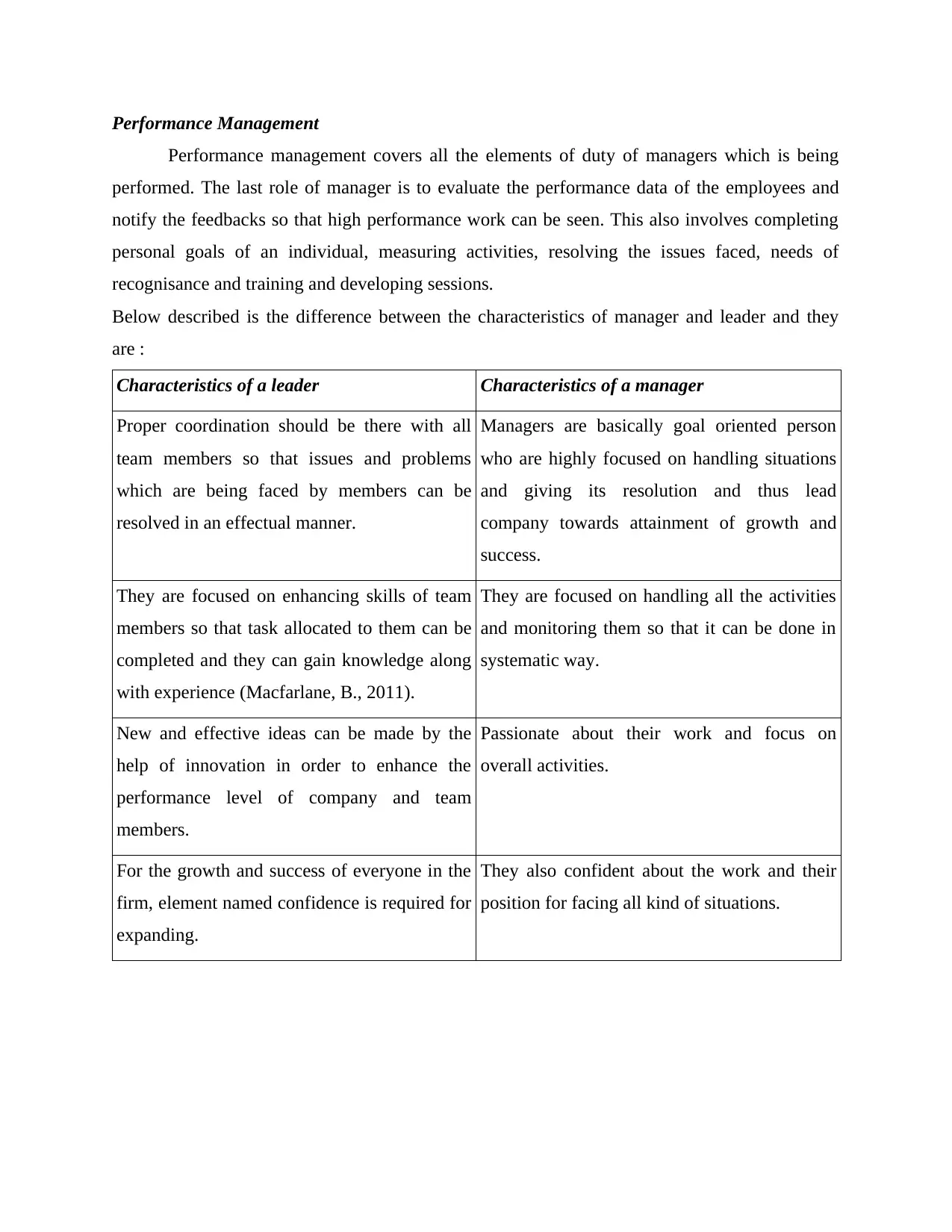
Performance Management
Performance management covers all the elements of duty of managers which is being
performed. The last role of manager is to evaluate the performance data of the employees and
notify the feedbacks so that high performance work can be seen. This also involves completing
personal goals of an individual, measuring activities, resolving the issues faced, needs of
recognisance and training and developing sessions.
Below described is the difference between the characteristics of manager and leader and they
are :
Characteristics of a leader Characteristics of a manager
Proper coordination should be there with all
team members so that issues and problems
which are being faced by members can be
resolved in an effectual manner.
Managers are basically goal oriented person
who are highly focused on handling situations
and giving its resolution and thus lead
company towards attainment of growth and
success.
They are focused on enhancing skills of team
members so that task allocated to them can be
completed and they can gain knowledge along
with experience (Macfarlane, B., 2011).
They are focused on handling all the activities
and monitoring them so that it can be done in
systematic way.
New and effective ideas can be made by the
help of innovation in order to enhance the
performance level of company and team
members.
Passionate about their work and focus on
overall activities.
For the growth and success of everyone in the
firm, element named confidence is required for
expanding.
They also confident about the work and their
position for facing all kind of situations.
Performance management covers all the elements of duty of managers which is being
performed. The last role of manager is to evaluate the performance data of the employees and
notify the feedbacks so that high performance work can be seen. This also involves completing
personal goals of an individual, measuring activities, resolving the issues faced, needs of
recognisance and training and developing sessions.
Below described is the difference between the characteristics of manager and leader and they
are :
Characteristics of a leader Characteristics of a manager
Proper coordination should be there with all
team members so that issues and problems
which are being faced by members can be
resolved in an effectual manner.
Managers are basically goal oriented person
who are highly focused on handling situations
and giving its resolution and thus lead
company towards attainment of growth and
success.
They are focused on enhancing skills of team
members so that task allocated to them can be
completed and they can gain knowledge along
with experience (Macfarlane, B., 2011).
They are focused on handling all the activities
and monitoring them so that it can be done in
systematic way.
New and effective ideas can be made by the
help of innovation in order to enhance the
performance level of company and team
members.
Passionate about their work and focus on
overall activities.
For the growth and success of everyone in the
firm, element named confidence is required for
expanding.
They also confident about the work and their
position for facing all kind of situations.
⊘ This is a preview!⊘
Do you want full access?
Subscribe today to unlock all pages.

Trusted by 1+ million students worldwide
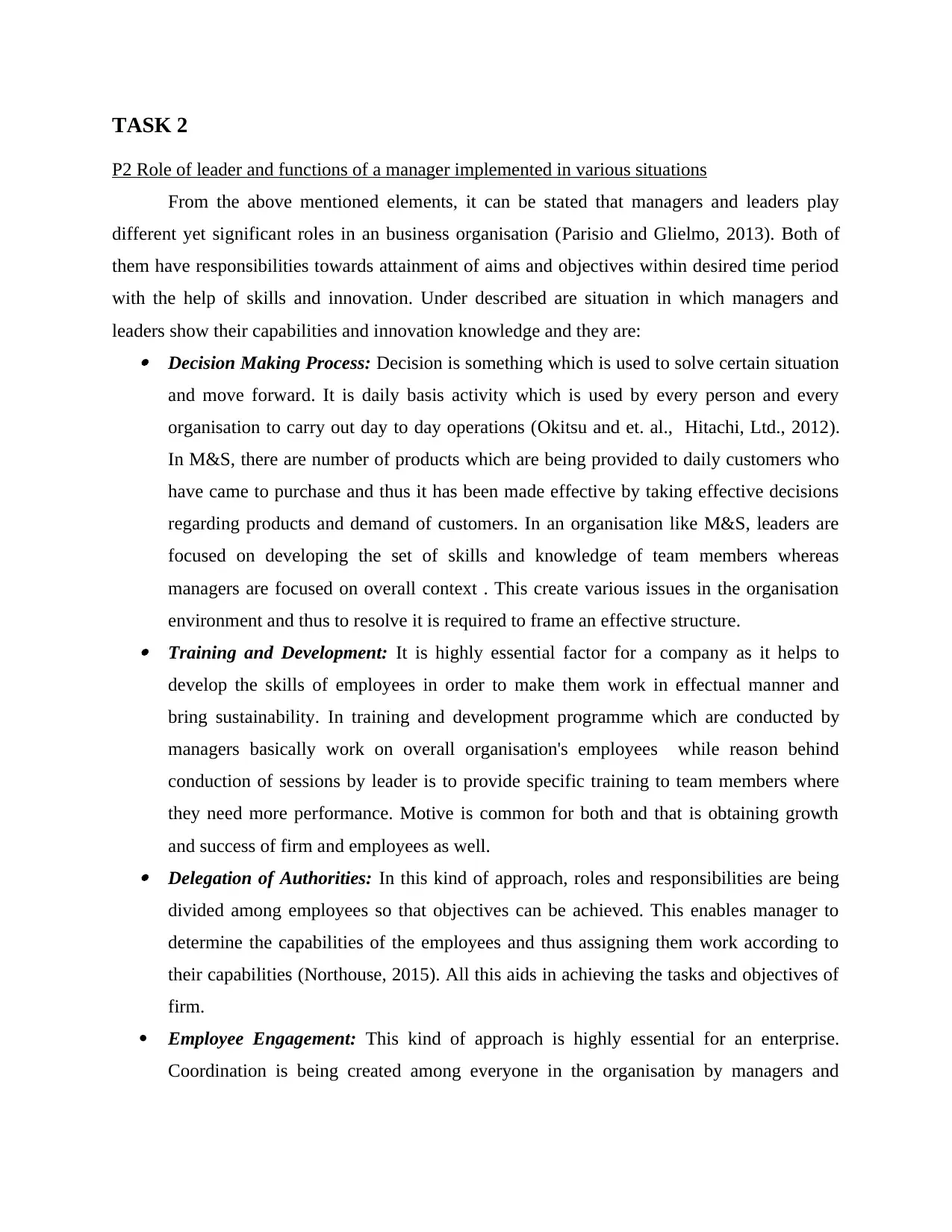
TASK 2
P2 Role of leader and functions of a manager implemented in various situations
From the above mentioned elements, it can be stated that managers and leaders play
different yet significant roles in an business organisation (Parisio and Glielmo, 2013). Both of
them have responsibilities towards attainment of aims and objectives within desired time period
with the help of skills and innovation. Under described are situation in which managers and
leaders show their capabilities and innovation knowledge and they are: Decision Making Process: Decision is something which is used to solve certain situation
and move forward. It is daily basis activity which is used by every person and every
organisation to carry out day to day operations (Okitsu and et. al., Hitachi, Ltd., 2012).
In M&S, there are number of products which are being provided to daily customers who
have came to purchase and thus it has been made effective by taking effective decisions
regarding products and demand of customers. In an organisation like M&S, leaders are
focused on developing the set of skills and knowledge of team members whereas
managers are focused on overall context . This create various issues in the organisation
environment and thus to resolve it is required to frame an effective structure. Training and Development: It is highly essential factor for a company as it helps to
develop the skills of employees in order to make them work in effectual manner and
bring sustainability. In training and development programme which are conducted by
managers basically work on overall organisation's employees while reason behind
conduction of sessions by leader is to provide specific training to team members where
they need more performance. Motive is common for both and that is obtaining growth
and success of firm and employees as well. Delegation of Authorities: In this kind of approach, roles and responsibilities are being
divided among employees so that objectives can be achieved. This enables manager to
determine the capabilities of the employees and thus assigning them work according to
their capabilities (Northouse, 2015). All this aids in achieving the tasks and objectives of
firm.
Employee Engagement: This kind of approach is highly essential for an enterprise.
Coordination is being created among everyone in the organisation by managers and
P2 Role of leader and functions of a manager implemented in various situations
From the above mentioned elements, it can be stated that managers and leaders play
different yet significant roles in an business organisation (Parisio and Glielmo, 2013). Both of
them have responsibilities towards attainment of aims and objectives within desired time period
with the help of skills and innovation. Under described are situation in which managers and
leaders show their capabilities and innovation knowledge and they are: Decision Making Process: Decision is something which is used to solve certain situation
and move forward. It is daily basis activity which is used by every person and every
organisation to carry out day to day operations (Okitsu and et. al., Hitachi, Ltd., 2012).
In M&S, there are number of products which are being provided to daily customers who
have came to purchase and thus it has been made effective by taking effective decisions
regarding products and demand of customers. In an organisation like M&S, leaders are
focused on developing the set of skills and knowledge of team members whereas
managers are focused on overall context . This create various issues in the organisation
environment and thus to resolve it is required to frame an effective structure. Training and Development: It is highly essential factor for a company as it helps to
develop the skills of employees in order to make them work in effectual manner and
bring sustainability. In training and development programme which are conducted by
managers basically work on overall organisation's employees while reason behind
conduction of sessions by leader is to provide specific training to team members where
they need more performance. Motive is common for both and that is obtaining growth
and success of firm and employees as well. Delegation of Authorities: In this kind of approach, roles and responsibilities are being
divided among employees so that objectives can be achieved. This enables manager to
determine the capabilities of the employees and thus assigning them work according to
their capabilities (Northouse, 2015). All this aids in achieving the tasks and objectives of
firm.
Employee Engagement: This kind of approach is highly essential for an enterprise.
Coordination is being created among everyone in the organisation by managers and
Paraphrase This Document
Need a fresh take? Get an instant paraphrase of this document with our AI Paraphraser
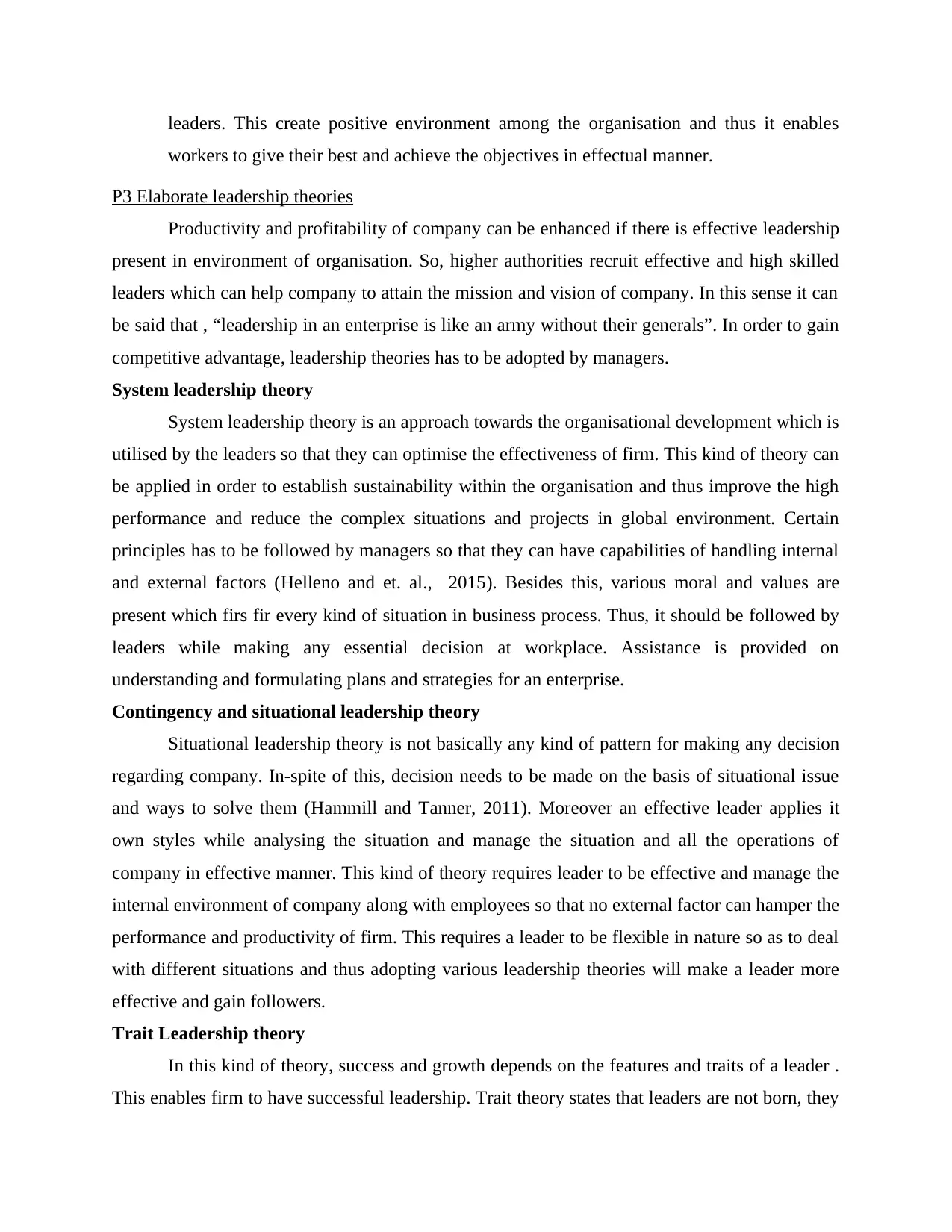
leaders. This create positive environment among the organisation and thus it enables
workers to give their best and achieve the objectives in effectual manner.
P3 Elaborate leadership theories
Productivity and profitability of company can be enhanced if there is effective leadership
present in environment of organisation. So, higher authorities recruit effective and high skilled
leaders which can help company to attain the mission and vision of company. In this sense it can
be said that , “leadership in an enterprise is like an army without their generals”. In order to gain
competitive advantage, leadership theories has to be adopted by managers.
System leadership theory
System leadership theory is an approach towards the organisational development which is
utilised by the leaders so that they can optimise the effectiveness of firm. This kind of theory can
be applied in order to establish sustainability within the organisation and thus improve the high
performance and reduce the complex situations and projects in global environment. Certain
principles has to be followed by managers so that they can have capabilities of handling internal
and external factors (Helleno and et. al., 2015). Besides this, various moral and values are
present which firs fir every kind of situation in business process. Thus, it should be followed by
leaders while making any essential decision at workplace. Assistance is provided on
understanding and formulating plans and strategies for an enterprise.
Contingency and situational leadership theory
Situational leadership theory is not basically any kind of pattern for making any decision
regarding company. In-spite of this, decision needs to be made on the basis of situational issue
and ways to solve them (Hammill and Tanner, 2011). Moreover an effective leader applies it
own styles while analysing the situation and manage the situation and all the operations of
company in effective manner. This kind of theory requires leader to be effective and manage the
internal environment of company along with employees so that no external factor can hamper the
performance and productivity of firm. This requires a leader to be flexible in nature so as to deal
with different situations and thus adopting various leadership theories will make a leader more
effective and gain followers.
Trait Leadership theory
In this kind of theory, success and growth depends on the features and traits of a leader .
This enables firm to have successful leadership. Trait theory states that leaders are not born, they
workers to give their best and achieve the objectives in effectual manner.
P3 Elaborate leadership theories
Productivity and profitability of company can be enhanced if there is effective leadership
present in environment of organisation. So, higher authorities recruit effective and high skilled
leaders which can help company to attain the mission and vision of company. In this sense it can
be said that , “leadership in an enterprise is like an army without their generals”. In order to gain
competitive advantage, leadership theories has to be adopted by managers.
System leadership theory
System leadership theory is an approach towards the organisational development which is
utilised by the leaders so that they can optimise the effectiveness of firm. This kind of theory can
be applied in order to establish sustainability within the organisation and thus improve the high
performance and reduce the complex situations and projects in global environment. Certain
principles has to be followed by managers so that they can have capabilities of handling internal
and external factors (Helleno and et. al., 2015). Besides this, various moral and values are
present which firs fir every kind of situation in business process. Thus, it should be followed by
leaders while making any essential decision at workplace. Assistance is provided on
understanding and formulating plans and strategies for an enterprise.
Contingency and situational leadership theory
Situational leadership theory is not basically any kind of pattern for making any decision
regarding company. In-spite of this, decision needs to be made on the basis of situational issue
and ways to solve them (Hammill and Tanner, 2011). Moreover an effective leader applies it
own styles while analysing the situation and manage the situation and all the operations of
company in effective manner. This kind of theory requires leader to be effective and manage the
internal environment of company along with employees so that no external factor can hamper the
performance and productivity of firm. This requires a leader to be flexible in nature so as to deal
with different situations and thus adopting various leadership theories will make a leader more
effective and gain followers.
Trait Leadership theory
In this kind of theory, success and growth depends on the features and traits of a leader .
This enables firm to have successful leadership. Trait theory states that leaders are not born, they
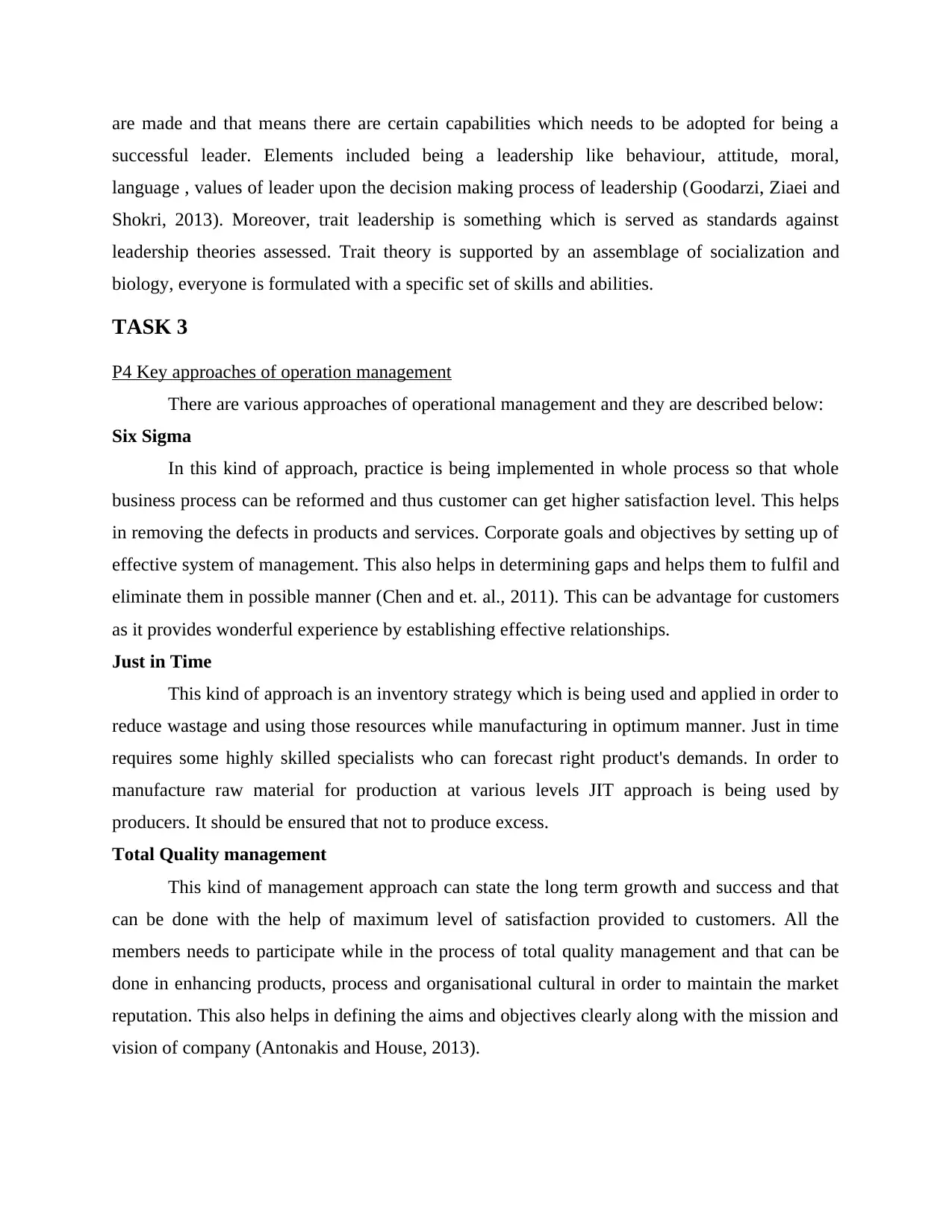
are made and that means there are certain capabilities which needs to be adopted for being a
successful leader. Elements included being a leadership like behaviour, attitude, moral,
language , values of leader upon the decision making process of leadership (Goodarzi, Ziaei and
Shokri, 2013). Moreover, trait leadership is something which is served as standards against
leadership theories assessed. Trait theory is supported by an assemblage of socialization and
biology, everyone is formulated with a specific set of skills and abilities.
TASK 3
P4 Key approaches of operation management
There are various approaches of operational management and they are described below:
Six Sigma
In this kind of approach, practice is being implemented in whole process so that whole
business process can be reformed and thus customer can get higher satisfaction level. This helps
in removing the defects in products and services. Corporate goals and objectives by setting up of
effective system of management. This also helps in determining gaps and helps them to fulfil and
eliminate them in possible manner (Chen and et. al., 2011). This can be advantage for customers
as it provides wonderful experience by establishing effective relationships.
Just in Time
This kind of approach is an inventory strategy which is being used and applied in order to
reduce wastage and using those resources while manufacturing in optimum manner. Just in time
requires some highly skilled specialists who can forecast right product's demands. In order to
manufacture raw material for production at various levels JIT approach is being used by
producers. It should be ensured that not to produce excess.
Total Quality management
This kind of management approach can state the long term growth and success and that
can be done with the help of maximum level of satisfaction provided to customers. All the
members needs to participate while in the process of total quality management and that can be
done in enhancing products, process and organisational cultural in order to maintain the market
reputation. This also helps in defining the aims and objectives clearly along with the mission and
vision of company (Antonakis and House, 2013).
successful leader. Elements included being a leadership like behaviour, attitude, moral,
language , values of leader upon the decision making process of leadership (Goodarzi, Ziaei and
Shokri, 2013). Moreover, trait leadership is something which is served as standards against
leadership theories assessed. Trait theory is supported by an assemblage of socialization and
biology, everyone is formulated with a specific set of skills and abilities.
TASK 3
P4 Key approaches of operation management
There are various approaches of operational management and they are described below:
Six Sigma
In this kind of approach, practice is being implemented in whole process so that whole
business process can be reformed and thus customer can get higher satisfaction level. This helps
in removing the defects in products and services. Corporate goals and objectives by setting up of
effective system of management. This also helps in determining gaps and helps them to fulfil and
eliminate them in possible manner (Chen and et. al., 2011). This can be advantage for customers
as it provides wonderful experience by establishing effective relationships.
Just in Time
This kind of approach is an inventory strategy which is being used and applied in order to
reduce wastage and using those resources while manufacturing in optimum manner. Just in time
requires some highly skilled specialists who can forecast right product's demands. In order to
manufacture raw material for production at various levels JIT approach is being used by
producers. It should be ensured that not to produce excess.
Total Quality management
This kind of management approach can state the long term growth and success and that
can be done with the help of maximum level of satisfaction provided to customers. All the
members needs to participate while in the process of total quality management and that can be
done in enhancing products, process and organisational cultural in order to maintain the market
reputation. This also helps in defining the aims and objectives clearly along with the mission and
vision of company (Antonakis and House, 2013).
⊘ This is a preview!⊘
Do you want full access?
Subscribe today to unlock all pages.

Trusted by 1+ million students worldwide
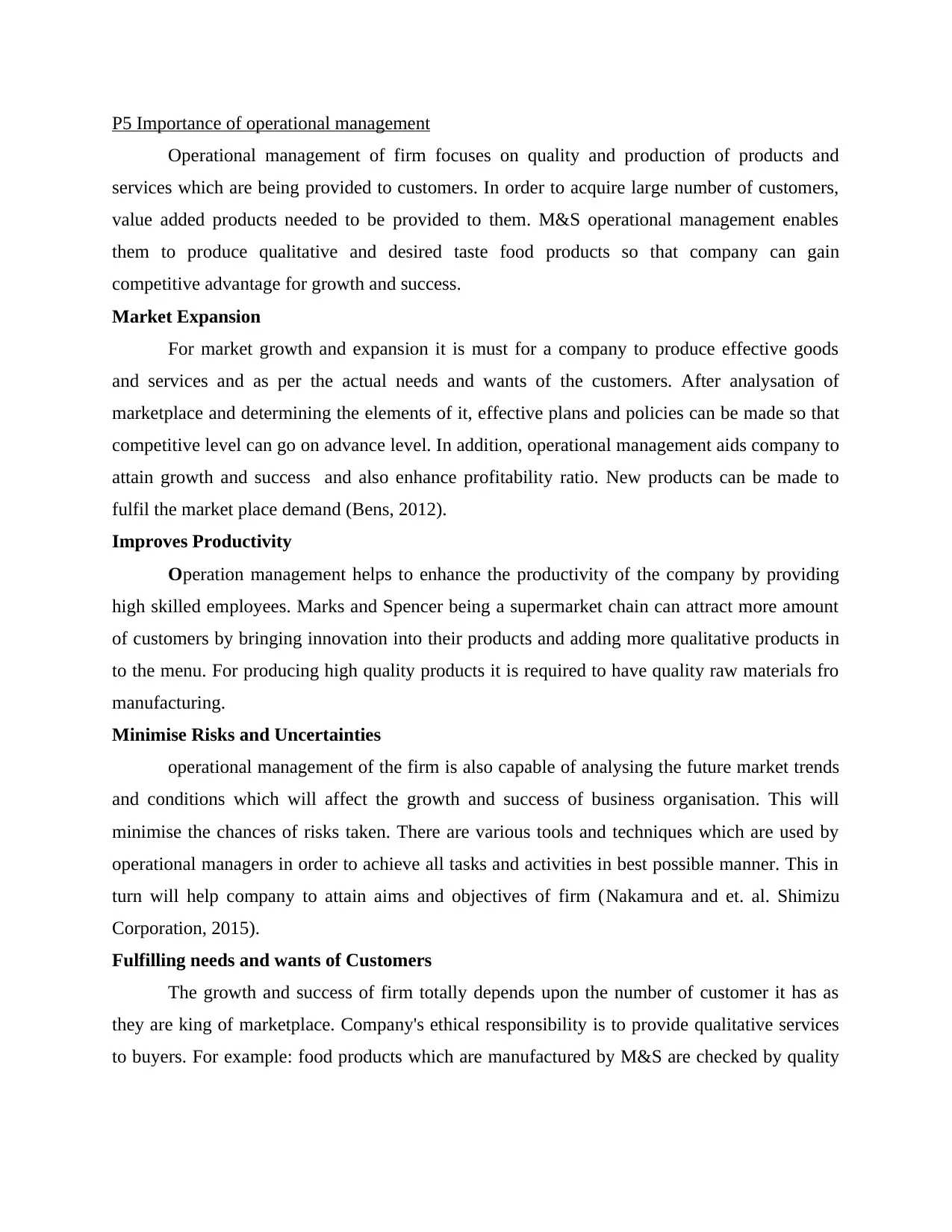
P5 Importance of operational management
Operational management of firm focuses on quality and production of products and
services which are being provided to customers. In order to acquire large number of customers,
value added products needed to be provided to them. M&S operational management enables
them to produce qualitative and desired taste food products so that company can gain
competitive advantage for growth and success.
Market Expansion
For market growth and expansion it is must for a company to produce effective goods
and services and as per the actual needs and wants of the customers. After analysation of
marketplace and determining the elements of it, effective plans and policies can be made so that
competitive level can go on advance level. In addition, operational management aids company to
attain growth and success and also enhance profitability ratio. New products can be made to
fulfil the market place demand (Bens, 2012).
Improves Productivity
Operation management helps to enhance the productivity of the company by providing
high skilled employees. Marks and Spencer being a supermarket chain can attract more amount
of customers by bringing innovation into their products and adding more qualitative products in
to the menu. For producing high quality products it is required to have quality raw materials fro
manufacturing.
Minimise Risks and Uncertainties
operational management of the firm is also capable of analysing the future market trends
and conditions which will affect the growth and success of business organisation. This will
minimise the chances of risks taken. There are various tools and techniques which are used by
operational managers in order to achieve all tasks and activities in best possible manner. This in
turn will help company to attain aims and objectives of firm (Nakamura and et. al. Shimizu
Corporation, 2015).
Fulfilling needs and wants of Customers
The growth and success of firm totally depends upon the number of customer it has as
they are king of marketplace. Company's ethical responsibility is to provide qualitative services
to buyers. For example: food products which are manufactured by M&S are checked by quality
Operational management of firm focuses on quality and production of products and
services which are being provided to customers. In order to acquire large number of customers,
value added products needed to be provided to them. M&S operational management enables
them to produce qualitative and desired taste food products so that company can gain
competitive advantage for growth and success.
Market Expansion
For market growth and expansion it is must for a company to produce effective goods
and services and as per the actual needs and wants of the customers. After analysation of
marketplace and determining the elements of it, effective plans and policies can be made so that
competitive level can go on advance level. In addition, operational management aids company to
attain growth and success and also enhance profitability ratio. New products can be made to
fulfil the market place demand (Bens, 2012).
Improves Productivity
Operation management helps to enhance the productivity of the company by providing
high skilled employees. Marks and Spencer being a supermarket chain can attract more amount
of customers by bringing innovation into their products and adding more qualitative products in
to the menu. For producing high quality products it is required to have quality raw materials fro
manufacturing.
Minimise Risks and Uncertainties
operational management of the firm is also capable of analysing the future market trends
and conditions which will affect the growth and success of business organisation. This will
minimise the chances of risks taken. There are various tools and techniques which are used by
operational managers in order to achieve all tasks and activities in best possible manner. This in
turn will help company to attain aims and objectives of firm (Nakamura and et. al. Shimizu
Corporation, 2015).
Fulfilling needs and wants of Customers
The growth and success of firm totally depends upon the number of customer it has as
they are king of marketplace. Company's ethical responsibility is to provide qualitative services
to buyers. For example: food products which are manufactured by M&S are checked by quality
Paraphrase This Document
Need a fresh take? Get an instant paraphrase of this document with our AI Paraphraser
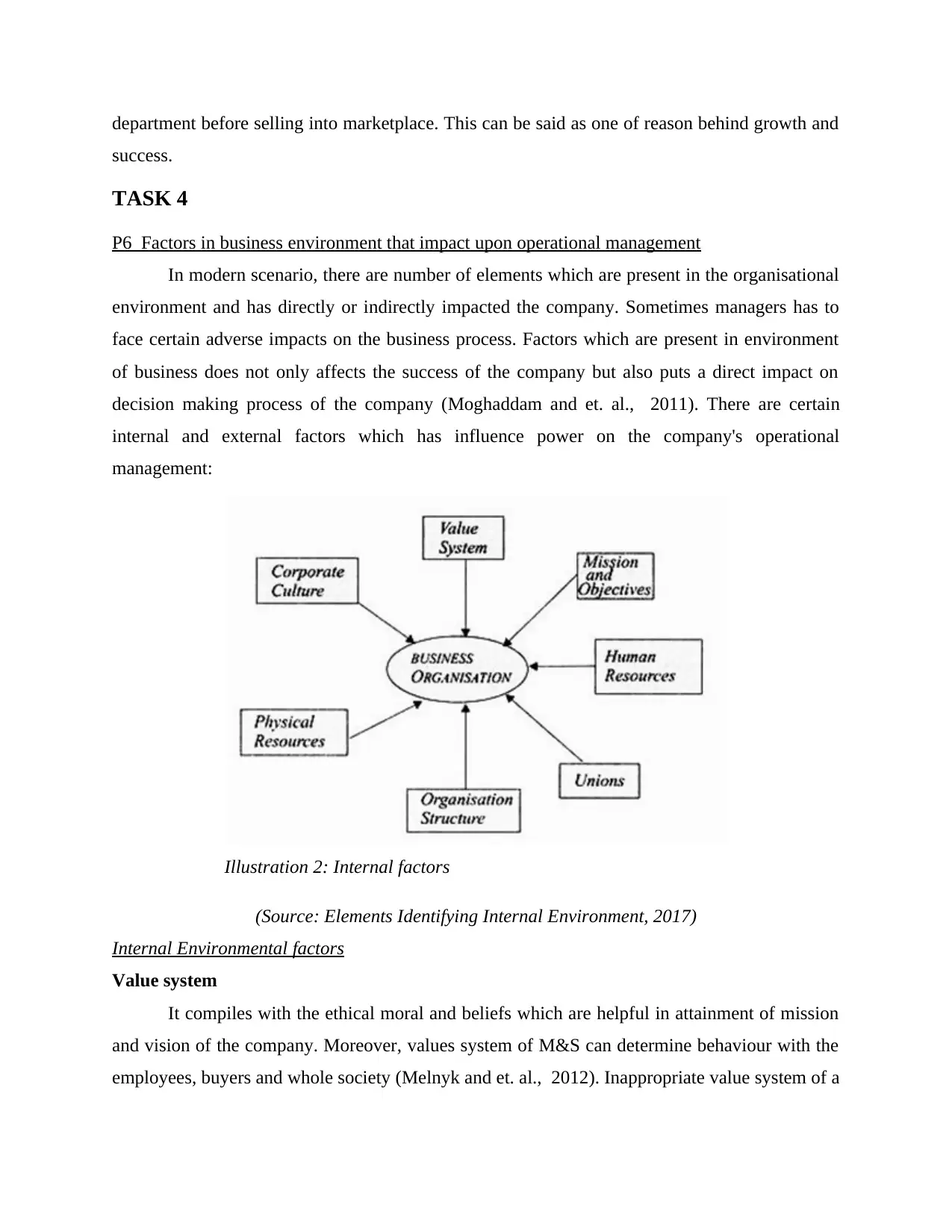
department before selling into marketplace. This can be said as one of reason behind growth and
success.
TASK 4
P6 Factors in business environment that impact upon operational management
In modern scenario, there are number of elements which are present in the organisational
environment and has directly or indirectly impacted the company. Sometimes managers has to
face certain adverse impacts on the business process. Factors which are present in environment
of business does not only affects the success of the company but also puts a direct impact on
decision making process of the company (Moghaddam and et. al., 2011). There are certain
internal and external factors which has influence power on the company's operational
management:
Illustration 2: Internal factors
(Source: Elements Identifying Internal Environment, 2017)
Internal Environmental factors
Value system
It compiles with the ethical moral and beliefs which are helpful in attainment of mission
and vision of the company. Moreover, values system of M&S can determine behaviour with the
employees, buyers and whole society (Melnyk and et. al., 2012). Inappropriate value system of a
success.
TASK 4
P6 Factors in business environment that impact upon operational management
In modern scenario, there are number of elements which are present in the organisational
environment and has directly or indirectly impacted the company. Sometimes managers has to
face certain adverse impacts on the business process. Factors which are present in environment
of business does not only affects the success of the company but also puts a direct impact on
decision making process of the company (Moghaddam and et. al., 2011). There are certain
internal and external factors which has influence power on the company's operational
management:
Illustration 2: Internal factors
(Source: Elements Identifying Internal Environment, 2017)
Internal Environmental factors
Value system
It compiles with the ethical moral and beliefs which are helpful in attainment of mission
and vision of the company. Moreover, values system of M&S can determine behaviour with the
employees, buyers and whole society (Melnyk and et. al., 2012). Inappropriate value system of a
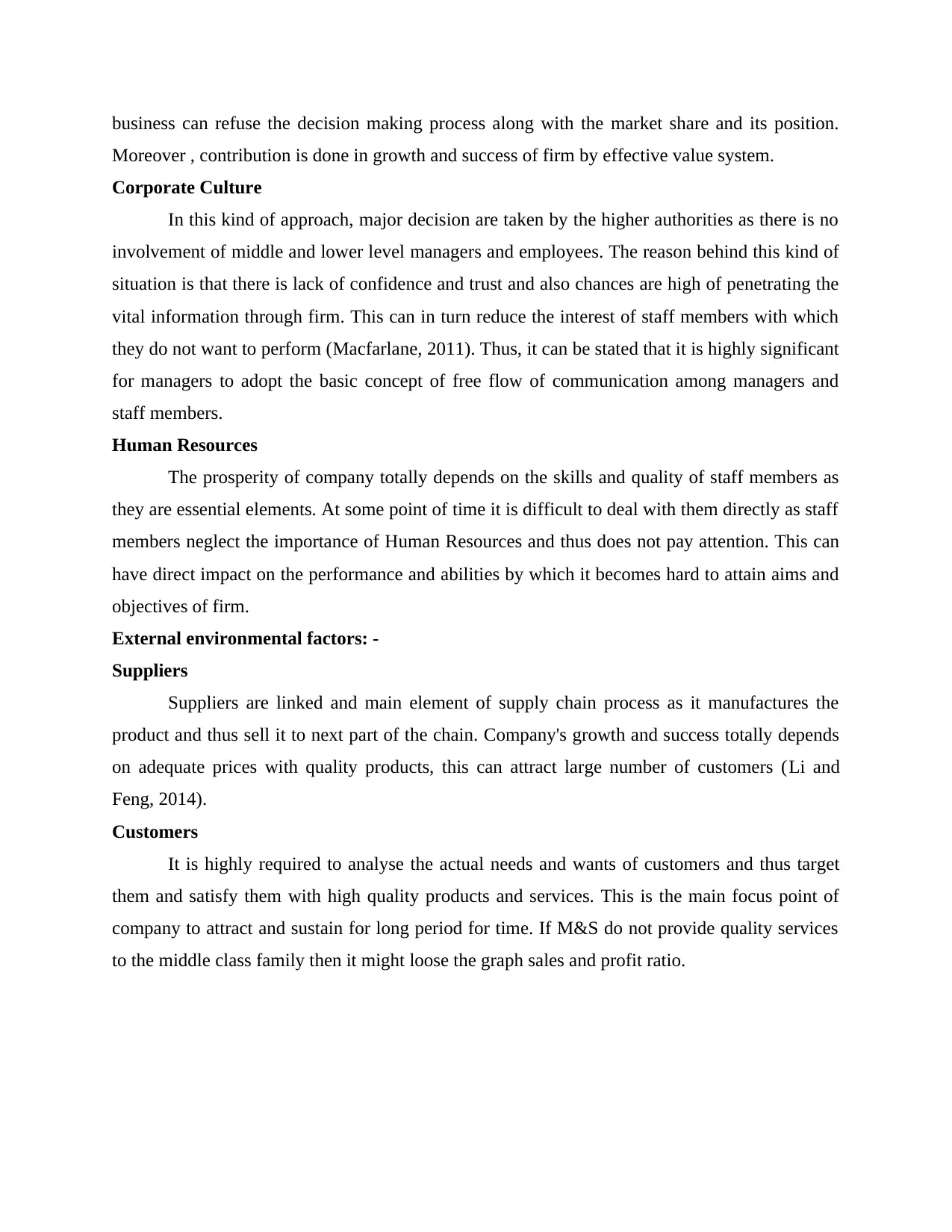
business can refuse the decision making process along with the market share and its position.
Moreover , contribution is done in growth and success of firm by effective value system.
Corporate Culture
In this kind of approach, major decision are taken by the higher authorities as there is no
involvement of middle and lower level managers and employees. The reason behind this kind of
situation is that there is lack of confidence and trust and also chances are high of penetrating the
vital information through firm. This can in turn reduce the interest of staff members with which
they do not want to perform (Macfarlane, 2011). Thus, it can be stated that it is highly significant
for managers to adopt the basic concept of free flow of communication among managers and
staff members.
Human Resources
The prosperity of company totally depends on the skills and quality of staff members as
they are essential elements. At some point of time it is difficult to deal with them directly as staff
members neglect the importance of Human Resources and thus does not pay attention. This can
have direct impact on the performance and abilities by which it becomes hard to attain aims and
objectives of firm.
External environmental factors: -
Suppliers
Suppliers are linked and main element of supply chain process as it manufactures the
product and thus sell it to next part of the chain. Company's growth and success totally depends
on adequate prices with quality products, this can attract large number of customers (Li and
Feng, 2014).
Customers
It is highly required to analyse the actual needs and wants of customers and thus target
them and satisfy them with high quality products and services. This is the main focus point of
company to attract and sustain for long period for time. If M&S do not provide quality services
to the middle class family then it might loose the graph sales and profit ratio.
Moreover , contribution is done in growth and success of firm by effective value system.
Corporate Culture
In this kind of approach, major decision are taken by the higher authorities as there is no
involvement of middle and lower level managers and employees. The reason behind this kind of
situation is that there is lack of confidence and trust and also chances are high of penetrating the
vital information through firm. This can in turn reduce the interest of staff members with which
they do not want to perform (Macfarlane, 2011). Thus, it can be stated that it is highly significant
for managers to adopt the basic concept of free flow of communication among managers and
staff members.
Human Resources
The prosperity of company totally depends on the skills and quality of staff members as
they are essential elements. At some point of time it is difficult to deal with them directly as staff
members neglect the importance of Human Resources and thus does not pay attention. This can
have direct impact on the performance and abilities by which it becomes hard to attain aims and
objectives of firm.
External environmental factors: -
Suppliers
Suppliers are linked and main element of supply chain process as it manufactures the
product and thus sell it to next part of the chain. Company's growth and success totally depends
on adequate prices with quality products, this can attract large number of customers (Li and
Feng, 2014).
Customers
It is highly required to analyse the actual needs and wants of customers and thus target
them and satisfy them with high quality products and services. This is the main focus point of
company to attract and sustain for long period for time. If M&S do not provide quality services
to the middle class family then it might loose the graph sales and profit ratio.
⊘ This is a preview!⊘
Do you want full access?
Subscribe today to unlock all pages.

Trusted by 1+ million students worldwide
1 out of 15
Related Documents
Your All-in-One AI-Powered Toolkit for Academic Success.
+13062052269
info@desklib.com
Available 24*7 on WhatsApp / Email
![[object Object]](/_next/static/media/star-bottom.7253800d.svg)
Unlock your academic potential
Copyright © 2020–2025 A2Z Services. All Rights Reserved. Developed and managed by ZUCOL.





